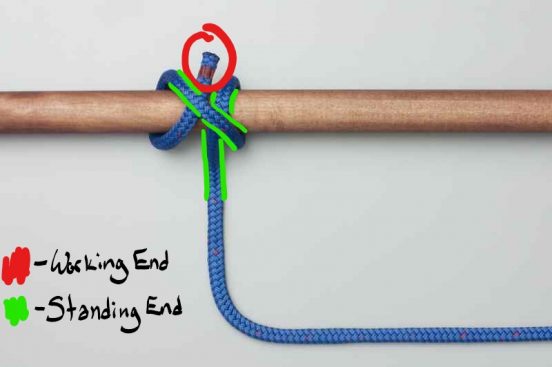This blog post is about specialized vocabulary, or jargon. Firstly, what it is, why it might be problematic, and why it is necessary in education to address jargon. Then, with use of the example of knot tying, I examine what I believe are the three conditions (Pace, Relevance, and Reinforcement) that must be met for successful instruction with the use of jargon.
———————————————
Anybody who has listened to a doctor speak with another medical professional can understand the feeling of hearing connected words, seemingly spoken in English, and still not understanding what their talking about.
Maybe for you it isn’t doctors. It could be the mechanic when you take your car in for an oil change, or a computer programmer, or a lawyer. Either way, different professions and practitioners of various activities have their own jargon. That is, a specialized vocabulary for their day to day objects, procedures, and tasks, etc.
(Relevant Simpson’s video [15 seconds])
There is no doubt that anyone listening to jargon that is not an insider is either left frustrated or just entirely out-of-the-loop. Now, it is important to note that specialized vocabulary develops for a specific purpose, namely, to express something that is particular to that profession. At times, these are legitimate English words that take on a specified meaning depending on their context.
“Gender-empowering multi-sectoral capacity building facilitates knowledge sharing and engages stakeholders in inclusive sustainability.” (Whaley, 2019).
That sentence is illustrative of a series of English that, individually, make sense, but together they are confusing to anyone outside of a particular group (in this case, International Development workers).
In other cases jargon is just slang words or clipped words (words that are intentionally shortened from their original form) that mean something to a particular group. When a doctor orders a ‘script’ they are referring to a ‘prescription’ and when the police refer to a ‘perp’ they mean ‘perpetrator’.
Jargon is really just a microcosm of language development. The language used by a group (or profession, or activity, or… etc.) changes based upon its needs, conventions, etc.. This is a form of Internal Language Change, but writ small (Haraya, 2016). Rather than language changes forming across a country, or region, or language group, it is morphing based on profession or activity or group.
Jargon, while helpful for the specific group, does have its drawbacks, however.
The largest of these drawbacks is that jargon makes information unclear (or outright unknowable) for outsiders. For example, in the realm of International Development, Floyd Whaley (who wrote the jargon-filled sentence referenced above) wrote an article that notes that “Jargon hurts the poor” (2018). His article explains that the overuse of technical language in International Development keeps vital information from people that need it the most. That if someone is trying to make use of information but cannot understand it, even if they have access to it, it is as if they didn’t have the information in the first place.
But what does this mean for education?
Jargon needs to be acknowledged in education
There are a number of topics that educators teach that are filled with jargon. Law 12 delves into the intricacies of a British common law system filled with unique nomenclature; carpentry makes use of miters, dovetails, and studs; upper level math and sciences might as well be taught in gobbledygook for those who haven’t sat through the class (and perhaps for some that have).
As an Outdoor Educator, I’ll look at jargon and education through this lens.
And, Outdoor Education is no different in terms of having a specialized set of vocabulary and jargon that can alienate the uninitiated. For example, if the weather was declining and you, an outdoor educator, turned to your students and asked them to set up their fly and tighten down the guyline, you might get a few confused looks and probably a wet tent (a fly is the outer, waterproof, part of the tent; a guyline is the cordage used to tie down a tent and tighten it to create tension that allows water to run off).

And so, my argument is this: teaching a specialized topic, like Outdoor Education, requires jargon, and jargon requires intention when being taught.
You may ask: “Is jargon even necessary?”
In short: yes!
Ignoring specialist language when teaching a subject is doing a disservice to your students. In the moment, it is perhaps easier for them to understand and learn the material, but over time they’ll be left out of the conversation in regards to the topic. If we as educators are introducing someone to a topic than jargon is part of that introduction.
However, I believe that there are three conditions to teaching jargon:
- PACE: teach jargon slowly
- KEEP IT RELEVANT: teach jargon only at the appropriate time during the lesson
- REINFORCE: repeat and reiterate jargon so that it can be digested, understood, and applied
Let’s have a look at a lesson in tying a bowline knot (a staple in outdoor knot tying):
This video by Animated Knots is a very useful visual aid for knot tying, and there are parts that are very helpful, and others that are not.
(12 seconds into video) The knot lesson jumps right in without noting what the parts of the rope are called. Next, the narrator says to leave a “long enough tail to make the bowline that you need.” However, this is not the typical term used in knot tying or the related professions, like sailing, rock climbing, and general outdoor activities. The Tail as the video calls it, is more frequently referred to as the Working End of the rope. Keeping terms consistent and in line with what is standard is important for future applications of knowledge and skill.
(21 seconds into video) Now, instruction is given to move the “Tail” around the “Standing End”. Because no vocabulary was offered at the beginning of the video to indicate which parts of the rope are which, the viewer has no concept of what the “Standing End” is.
My intention is not to nitpick, and undoubtedly AnimatedKnots.com is an extremely useful resource for knot tying. Their visual illustrations are clear and obvious, and so in that way they are successful for teaching knot tying.
However, without dedicated instruction on parts of a knot or parts of a rope, the skill of tying a bowline might not be as transferable as it could be. If a student was taught a bowline and then asked to tie a different knot, a lot of time could be saved if they already have knowledge about what the parts of a knot are, not to mention the confusion that could be saved by simply laying out what parts are called before referring to them.
In this way, students are set up for success, not just in this activity, but in related future activities too.
So, how do those three conditions for jargon instruction play out in this lesson?
PACE and RELEVANCE
The video did not outline the terms at all, but it also didn’t overwhelm the view by giving an information dump. If an instructor were to explain that the ‘tail’ of the rope is the Working End and the other end is the Standing End, and that the middle of the rope is the Bight, and that folding a middle section of rope so that two sections of rope are touching (but not overlapping) is also called a Bight, and that there are a variety of different varieties of knots such as Bends, Hitches, Quick Releases, and Loops, things would get confusing quickly. This is moving too quickly (PACE) and is irrelevant (RELEVANCE).
With pace, there is also the need for literal slowness of instruction. When a term is newly introduced it can be confusing, so taking time to properly explain the term and make sure everyone understands before moving on is also a key to this condition of jargon instruction.
REINFORCEMENT
A video is a good medium for reinforcement because the viewer can pause and replay sections or the video in its entirety. This reinforces the lesson. But, by also reiterating terms and reinforcing the jargon as the instructions are given, unfamiliar terms have an opportunity to become more familiar and better understood. Each time you use the term Working End of a rope, making note that it is the Working End will keep everyone on the same page and more clearly impress the jargon onto the student.
An Example:
Let us look at an example using a different knot, the Clove Hitch:
- Instructor gives an explanation of what a hitch is and how a Clove Hitch is used (Instructor ignores other knot types, such as Bends) [PACE and RELEVANCE]
- Instructor teaches the parts of the rope are used for this knot (the Working End and the Standing End) and ensures that it is understood [PACE and RELEVANCE]
- Instructor ignores non-useful terms such as Bight. [PACE and RELEVANCE]
- Instructor reiterates vocabulary as you go along. E.g. The Working End (indicate the working end) is passed over the pole and then underneath. [REINFORCEMENT]
Here are stills from another Animated Knots tutorial, and beside them are the conditions of jargon instruction set out:
1.
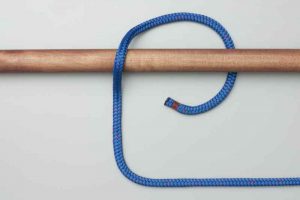
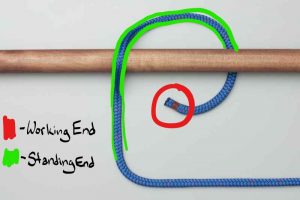
2.


3.
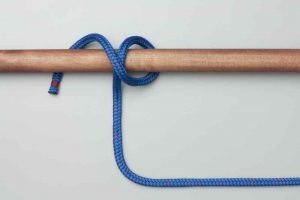

4.
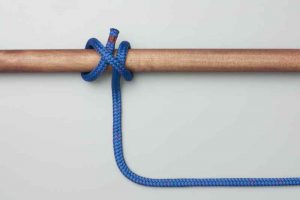
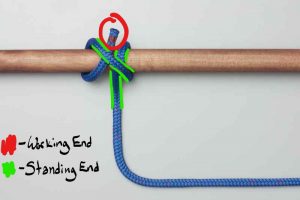
5.
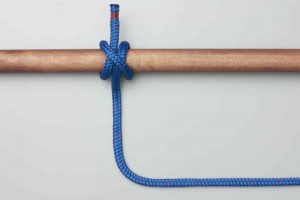
It should be noted that the use of visual aids gives the jargon context. And not introducing unnecessary terms allows for the current vocabulary to be the focus so it doesn’t get lost in a jumble of unfamiliar terms.
Now, at the end of that lesson, it should be clear to the students which end of the rope is which. When a more complex knot, such as a truckers Hitch is taught, the vocabulary learned through the Clove Hitch will help the student learn by removing some sources of confusion and allowing them to focus only on the new material.
In sum, jargon and specialized vocabulary, are a part of many subjects educators teach. This unique lexicon can be a source of confusion to outsiders, but can also be necessary in better understanding the subjects that the jargon describes and for a more complete understanding as well. For that reason, jargon should not be ignored. Firstly, because it leaves out material that is pertinent to the subject. Secondly, because, when taught well, the jargon makes the material understood more completely. Overuse of jargon, however, should be avoided so as not to create a barrier to knowing.
In order to be taught well, jargon must be taught with intention. It must be taught in manageable pieces, not all at once (PACE); at the appropriate time, so as to connect new terms with the proper information and to not overwhelm with non-essential terms (RELEVANCE); and jargon must be reinforced and reiterated so that it sticks (REINFORCEMENT).
Work cited:
animatedknots.com (n.d.) Clove Hitch – Rope End. Retrieved on September 20, 2019 from https://www.animatedknots.com/clove-hitch-knot-rope-end
AnimatedKnots (2011, June 18) How to Tie a Bowline Knot . Retrieved from https://www.youtube.com/watch?v=YXRnPES0Qec
Haraya, T.D. (2016) Language Change and Development: Historical Linguistics, Premise Journal (5)1, pp. 103-117. Retrieved on September 20, 2019 from https://www.researchgate.net/publication/319933801_LANGUAGE_CHANGE_AND_DEVELOPMENT_HISTORICAL_LINGUISTICS/fulltext/59c27027a6fdcc69b92ff9d6/LANGUAGE-CHANGE-AND-DEVELOPMENT-HISTORICAL-LINGUISTICS.pdf
Whaley, F. (2019) Jargon Hurts the Poor. Asian Development Blog, retrieved on September 20, 2019 from https://blogs.adb.org/blog/jargon-hurts-poor
